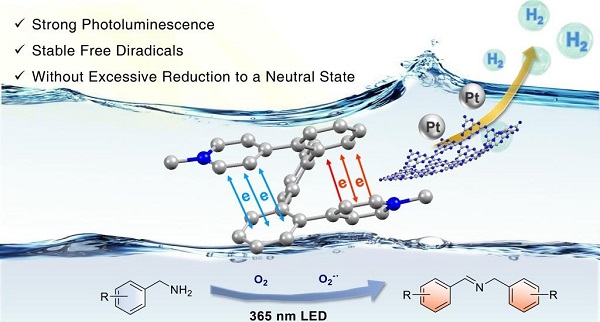New progress on viologens with through-space conjugation
Researchers in Xi'an Jiaotong University (XJTU) introduced the sterically conjugated structure into the viologen framework for the first time, and successfully created a series of sterically conjugated viologen derivatives (o-TPV2+).
The separation of two pyridine units by a through-space conjugation can prevent the excessive reduction of viologens to a quinoid structure and improve the free radical stability.
In addition, the through-space conjugation can stabilize the intramolecular charge transfer, delay the charge recombination process, and greatly improve its utilization efficiency in photocatalysis.

Titled ortho-Terphenylene Viologens with Through-Space Conjugation for Enhanced Photocatalytic Oxidative Coupling and Hydrogen Evolution, the research results were published in the Journal of the American Chemical Society. (Link to the paper: https://pubs.acs.org/doi/10.1021/jacs.1c11577)
Master student He Ben is the first author of this paper. Professor He Gang of the Frontier Institute of Science and Technology is the corresponding author, and XJTU is the only corresponding author unit. Researcher Rao Bin from XJTU's School of Chemistry, and Associate Professor Zhang Lei from Xidian University also participated in this research.
As classical organic redox substances, viologen compounds have stable oxidation states, excellent electron acceptability and good redox properties, so they are widely used in electrochromic devices, energy storage, supramolecular self-assembly, host-guest chemistry and other fields.
Through-space conjugation is an important class of p-electron delocalized systems. Its most important feature is that the ring interactions of aromatic rings depend on the ring-to-face stacking overlap rather than electron transport through covalent bonds. The special structure of through-space conjugation molecules makes them have great application prospects in the fields of aggregation-induced luminescence and thermally activated delayed fluorescence.
Combining the through-space conjugation with viologen can separate the two pyridine units of viologens while maintaining the uniform distribution of the conjugated electron cloud, avoiding the excessive reduction of viologens to a neutral state. At the same time, it is also expected to reduce the viologen to a neutral state. The combination of good redox properties and special electron transfer properties of the sterically conjugated structure shows superior performance in the field of photocatalysis.

